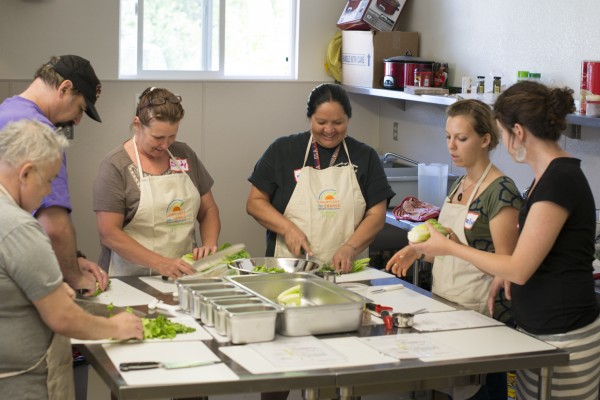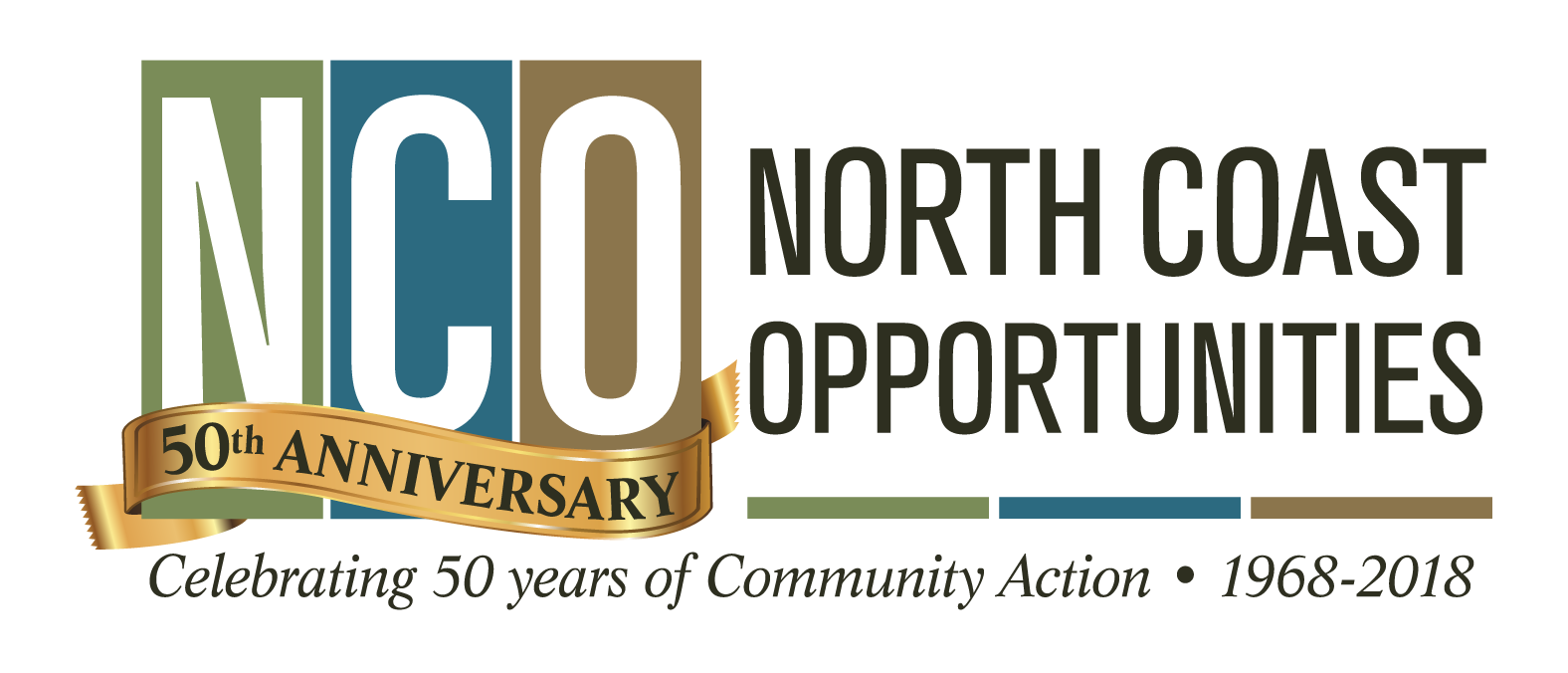
Above: Instructors and participants chop vegetables for a kale stew at the first Cocer cooking class held on May 1 at the Buddy Eller Center.
Community Cooking at the Buddy Eller Center
Wednesday, May 1, 2013
Three young women move calmly around an unfamiliar kitchen, taking gleaming knives out of packages and pulling price tags off utensils.
It’s an hour before the first of a four-part cooking class at the Buddy Eller Center, and these three local Community HealthCorps members are responsible for its conception and execution. (Community HealthCorps, a component of AmeriCorps, is a government-sponsored program in which 75,000 young adults complete a year of service with nonprofit organizations around the country.)
The cooking class is named “Cocer” after the Spanish verb “to cook,” and it stands for Community Organized Cooking and Edible Resources. Lucy Shapiro and Jessica Ohland are Community HealthCorps Navigators with the Mendocino Community Health Center, and Natalie Loots, also with Community HealthCorps, is the Hunger Prevention Coordinator with The Gardens Project of North Coast Opportunities Community Action (NCO).
The class was cooked up during a number of discussions among the women. “We all care about food access and nutrition, and we wanted to find a way to incorporate that into our year of service,” says Shapiro, a second-year AmeriCorps member from Virginia.
Together, they wrote a Ukiah Natural Foods Co-Op grant to furnish the commercial kitchen at the Buddy Eller Center with much-needed utensils. Additional funding for ingredients came from NCO and the Ford Street Project.
The available class spots filled quickly. In all there are 16 registered participants, 10 of which are children under the age of six. Today, seven adults and six kids have come to cook. They start with a quiz about making healthy choices and then move on to introductions, stating their names, favorite fruit and vegetable, and why they’re taking the class. “I don’t really like to cook, but I’m here because I’d like to learn how to eat better,” says Cindy, a class participant. “I’d like to be a healthier person.”
The class then splits up – the kids go outside as the adults migrate to the kitchen to prepare Nellie’s Kale Stew, a recipe from the California Department of Public Health’s Network for a Healthy California. “I’ve never cooked with kale before,” says class participant Michelle. “I actually don’t even know what it is!”
As the adults chop and converse inside, outside the kids draw vegetables and listen to “Stone Soup,” a story about a hungry community that comes together to cook a meal using what they have. Then they use kid-friendly knives to chop vegetables for the salad bar.
Adrian Brumley, Housing Director at the Buddy Eller Center, is on hand to observe the class and help with the kids – two of whom are his own. The kitchen is dedicated to the approximately 50 people in nearby transitional housing, where residents can live for up to two years as they get back on their feet. “Every night they get food from the Ford Street Project food bank and cook together,” says Brumley.
Cocer aims to show these residents healthy yet simple recipes to prepare together. “We wanted to offer a class that’s practical,” says Ohland, a first-year AmeriCorps member who has lived in Ukiah for ten years. “How can you cook a healthy dinner with your kids? What can they do to help?” In a future class they will take a trip to the farmer’s market to learn how to use their EBT funds and explore the food available from local farms, and for the final class the participants will prepare a community dinner. By the end, each participant will have a binder filled with recipes and notes on how to prepare nutritious food.
This first class is well organized and positively received by the participants, who chop and talk and laugh easily with the instructors. Perhaps more importantly, the food itself is well-received: everyone takes generous portions of salad, complete with homemade yogurt dressing, and big bowls of soup. As they eat, the group shares creative salad ideas and discusses how the soup recipe could be modified to use different ingredients. It’s a casual, friendly environment in which instructors and participants converse on equal grounds – no one seems uncomfortable or embarrassed, and everyone is proud of the meal they made and shared together.
Now that the kitchen supplies have been purchased and the groundwork laid, “we could potentially do a second session” if more funding for food is available, says Loots, a first-year AmeriCorps volunteer from Iowa. They’ll need to decide quickly if a second session is possible for them – each of their service terms ends in July.
Loots is unsure what the future holds. “Would I do a second AmeriCorps term? Will I stay in Ukiah? Maybe!” she laughs. “I’m open.” Ohland is headed to graduate school in Denmark to study public health, and Shapiro hopes to find a job in community health outreach and education, ideally in the area. “I don’t think I’m ever going to leave California,” she says. “I love it here.”
The AmeriCorps program attracts intelligent and driven young adults to the area, many of whom stay on to work in the communities they served. In September, a new crop of AmeriCorps members will fill the shoes left vacant by these three community-minded women. Among other resources, their replacements will have at their disposal a blueprint for change, one cooking class at a time.
